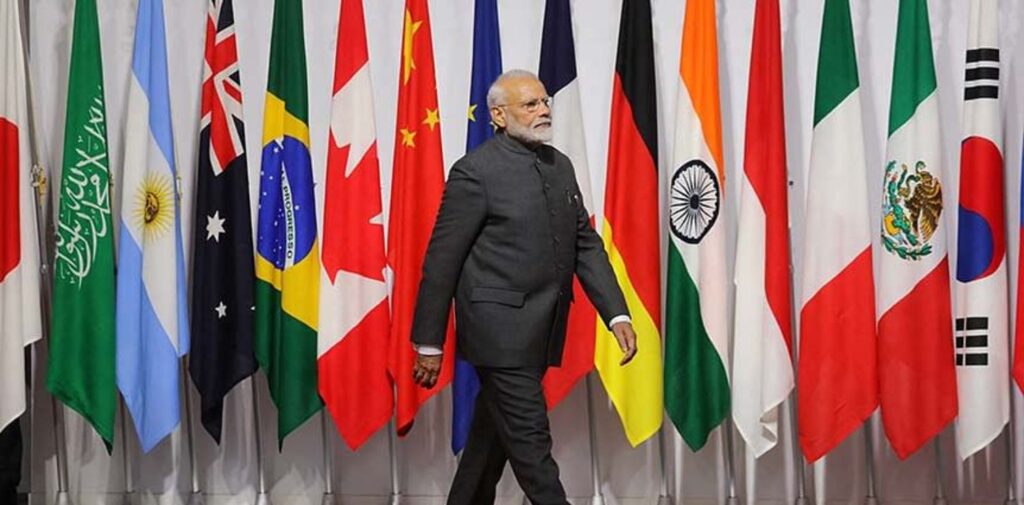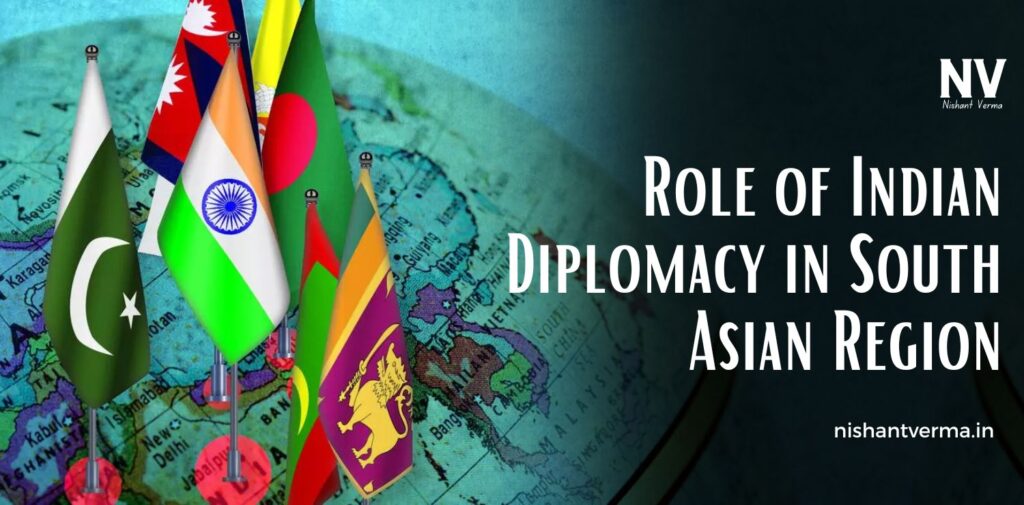India, as one of the largest and most influential countries in South Asia, plays a pivotal role in shaping the political, economic, and security landscape of the region. Indian diplomacy has been central in fostering relations with its neighbors, promoting regional stability, and addressing challenges such as terrorism, trade, and climate change. This article delves into India’s role in the South Asian region, exploring how Indian diplomacy has contributed to peace, growth, and cooperation, while also examining the challenges it faces in maintaining strong ties with its neighbors.
India’s Influence in South Asia
India’s position as a regional power is unique due to its size, economic strength, and military capabilities. With a population of over 1.3 billion, India is the largest democracy in the world and has the second-largest economy in Asia. Its geographical location at the heart of South Asia gives it strategic importance, influencing both political and economic dynamics across the region.
The country’s role in South Asia is not just limited to its direct relations with neighboring countries. India is deeply involved in regional organizations such as the South Asian Association for Regional Cooperation (SAARC) and the Bay of Bengal Initiative for Multi-Sectoral Technical and Economic Cooperation (BIMSTEC). Through these platforms, India fosters cooperation on key issues such as economic growth, climate change, regional connectivity, and counterterrorism.
India’s diplomacy in the region is guided by the principles of peace, cooperation, and mutual respect. It seeks to promote stability by fostering good relations with its neighbors, managing conflicts through dialogue, and offering support for economic development.

Building Strong Bilateral Relations
Indian diplomacy focuses on strengthening bilateral relationships with its South Asian neighbors, particularly countries such as Pakistan, Bangladesh, Sri Lanka, Nepal, Bhutan, and the Maldives. While the relationships vary from one country to another, India has consistently tried to balance its national interests with the region’s collective well-being.
With Pakistan, India has a complex and challenging relationship, primarily due to historical issues such as the Kashmir dispute. However, India continues to emphasize dialogue and diplomacy to resolve conflicts and improve bilateral ties. India’s approach involves addressing security concerns, promoting cross-border trade, and improving people-to-people exchanges.
On the other hand, relations with countries like Nepal, Bangladesh, and Bhutan have been more cooperative. India shares strong cultural, economic, and historical ties with these countries, which have helped in fostering mutual understanding and collaboration. For instance, India has been instrumental in providing economic assistance to Nepal and Bangladesh, supporting infrastructure projects, and helping these countries tackle developmental challenges.
In Sri Lanka, India has maintained strong economic and political relations, helping in post-civil war reconstruction and providing humanitarian assistance. India’s diplomatic role in Sri Lanka includes encouraging reconciliation efforts between the government and Tamil communities, supporting economic growth, and addressing security issues, especially in the Indian Ocean region.
Economic Cooperation and Regional Connectivity
India’s diplomacy in South Asia is also strongly focused on economic cooperation and regional integration. India has one of the largest economies in the region, and it plays a central role in driving economic growth. The country has fostered trade agreements with its neighbors, offered financial assistance, and helped improve infrastructure to boost regional connectivity.
One of the key initiatives taken by India is the South Asia Free Trade Area (SAFTA), which aims to promote free trade among SAARC countries. India has been at the forefront of promoting regional economic integration, not only through SAFTA but also by participating in various regional cooperation frameworks like BIMSTEC. India’s investments in infrastructure, such as roads, railways, and energy projects, help connect South Asian countries and promote intra-regional trade.
For example, India’s relationship with Bangladesh has flourished due to collaborative trade initiatives, energy projects, and shared water resources management. Similarly, India is working on improving connectivity with Nepal and Bhutan, providing financial and technical support for infrastructure projects that enhance trade and transport links.

Promoting Regional Security and Counterterrorism Cooperation
Regional security is another area where India’s diplomacy plays a crucial role. India is committed to ensuring peace and stability in South Asia, particularly in dealing with cross-border terrorism, border disputes, and the rise of extremist threats. India’s relationship with Pakistan, in particular, has been affected by concerns over terrorism, as India has frequently accused Pakistan of harboring terrorist groups that target Indian civilians and security forces.
Despite these challenges, India continues to call for dialogue and peace efforts with Pakistan. The Indian government has made it clear that terrorism must end before any meaningful negotiations can occur. At the same time, India works with other countries in the region to strengthen counterterrorism cooperation, share intelligence, and combat organized crime and extremism.
India also actively participates in multilateral security frameworks such as the Indian Ocean Rim Association (IORA) and the Shanghai Cooperation Organization (SCO), which focus on security and stability in the Indian Ocean region and the broader Asia-Pacific area. Through these platforms, India collaborates with other countries to address security concerns and protect maritime trade routes, which are vital to the region’s economic health.
Challenges to Indian Diplomacy in South Asia
Despite its strong diplomatic efforts, India faces several challenges in maintaining stable and constructive relationships with its neighbors. One of the biggest challenges is the complex geopolitical dynamics in South Asia. India’s relations with Pakistan remain tense due to ongoing disputes, particularly over Kashmir, and the problem of cross-border terrorism. Although India has made efforts to engage Pakistan diplomatically, mistrust and security concerns continue to complicate the relationship.
Another challenge is India’s growing competition with China in the region. China’s increasing presence in South Asia, particularly through its Belt and Road Initiative (BRI), has raised concerns in India. China’s growing influence in countries like Sri Lanka, Nepal, and Pakistan poses a strategic challenge to India’s role in the region. India’s diplomacy has focused on balancing this competition by strengthening its relations with other regional players, improving infrastructure, and increasing its economic influence.
Additionally, internal political instability in some South Asian countries, such as Nepal and Sri Lanka, has made it difficult for India to engage effectively. While India has offered assistance in these countries, political turmoil can create obstacles for sustained diplomatic efforts.

India’s Role in Promoting Climate Change and Sustainable Development
India also plays a significant role in addressing climate change and promoting sustainable development in the region. As a large and rapidly developing country, India faces challenges related to environmental degradation, resource management, and climate change. At the same time, India has a vested interest in promoting environmental sustainability in the South Asian region as a whole.
India has been actively involved in regional initiatives aimed at tackling climate change, such as the South Asian Association for Regional Cooperation (SAARC) Environmental Programme. India has also pushed for increased investment in renewable energy and green technologies in South Asia, which can help reduce carbon emissions and promote sustainable development.
India is particularly focused on water resources management, given the shared rivers that flow through South Asia. The country has worked with neighbors like Bangladesh, Nepal, and Bhutan to manage cross-border water resources, ensuring that water scarcity issues are addressed in a fair and cooperative manner.
Conclusion: India’s Continuing Diplomatic Efforts in South Asia
India’s role in South Asia remains crucial for the region’s stability, security, and economic growth. Through its diplomatic efforts, India seeks to build strong relationships with its neighbors, promote economic integration, address security challenges, and foster regional cooperation. While challenges such as cross-border terrorism, geopolitical competition, and internal political instability remain, India’s commitment to regional peace and prosperity continues to drive its diplomatic agenda.
In cities like Hisar, where people are increasingly aware of global issues, understanding India’s role in South Asia helps us appreciate the broader context of our country’s foreign policy. India’s diplomacy not only impacts the country’s relationship with its neighbors but also influences global trade, security, and environmental sustainability. As India continues to evolve as a regional and global power, its efforts in South Asia will shape the future of the region and contribute to a more peaceful, prosperous, and cooperative world.




